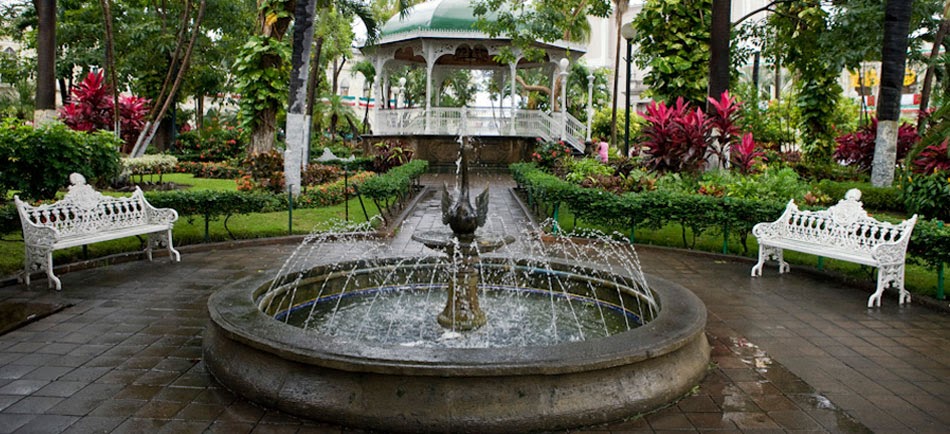Colima, capital of the small Mexican state of the same name, is a peaceful city. Located in the western region of Mexico , near the Pacific coast , in a valley between two volcanoes: Volcan de Fuego, still active and the Nevado de Colima, inactive and snowy . The "City of Palms " is covered by banana and coconut palms , in
addition, has a pleasant climate throughout the year. He has been named one of the safest and most livable cities in Mexico .
Colima 's main square is the Liberty Garden , located in the heart of the city. Admira Portal Medellin , a row of arches in the northern section , and Portal Morelos , in the southern section . Can you see the Cathedral and the city , next to the impressive Government Palace. Spend the afternoon relaxing in the garden and enjoy the climate of Colima. It is unusual to find musicians in the gazebo while people dance . Do not forget to test the water of tuba, a local specialty.
Colima Cathedral was built in 1527 and has been rebuilt several times , most recently in 1941. Neoclassical facade and ships dating from 1894. The dome windows allow light to enter into sparsely decorated . The Government Palace , built between 1894 and 1904 with the same neoclassical cathedral , contains murals by local artist , Jorge Chávez Carrillo , who tell stories of revolutionary heroes and indigenous culture. The first floor houses a small museum of archeology.
While you are in Colima, do not stop visiting some of the great museums of the city as the Regional History Museum , the University Museum of Popular Arts and Pinacoteca Universitaria Alfonso Michel , which displays some of the works by this artist.
La Campana , stories carved in stone
A fertile land near the sea gods and fire, was undoubtedly the ideal medium for pre-Hispanic cultures built their cities. Colima 's roots date back to ancient times and can observe in El Chanal and La Campana, best known archaeological sites in the state. Inhabited between 100 thousand and thousand year 400 BC, these cities have a complex business , social and religious organization . As in modern cities , some buildings were public and were part of the interaction between citizens and government and religious authorities , but others were unique to rulers and priests.
Here you can admire the ballgame , evidence of indigenous religious beliefs. Xolotl , a deity associated with the game , in pre-Hispanic mythology was the companion of the sun while he was in the underworld during the night. Venus, the morning star , was the herald of victory of Tonatiuh , the sun god .
As it is near the Pacific Ocean, and as a frequent rains gift, it is not surprising that temples dedicated to Tlaloc, the rain god are. On a more pragmatic aspect of water management has been a priority in these ancient cities , who were pioneers in building drainage systems.
The people shared , as virtually all Mexican cultures, their devotion to the past , which was manifested in public , private and religious traditions ceremonies. But this is not just an archaeological fact : if you run into Mexico before November 2 , find these beliefs more alive than ever .
The main temple of La Campana is decorated with images and Ehécatl Tlaloc ( god of wind ) . The newly discovered Xipetotec figures are indicative of a relationship with Tula , one of the largest cities in central Mexico . An earthquake was the primary cause of their destruction, years later, the Spanish conquistadors contributed to this by using the stones to build temples Catholic chapels .
Your passport to authentic travel experiences. Explore diverse cultures, savor local cuisines, and create lasting memories. Our travel blog offers tips, itineraries
Usamos cookies propias y de terceros que entre otras cosas recogen datos sobre sus hábitos de navegación para mostrarle publicidad personalizada y realizar análisis de uso de nuestro sitio.
Si continúa navegando consideramos que acepta su uso. OK Más información | Y más
Si continúa navegando consideramos que acepta su uso. OK Más información | Y más
Recent
Popular
-
Are you dreaming of a trip to South America? Argentina offers a diverse range of landscapes, from towering mountains to vast plains, maki...
-
The daily life of Sinaloa people always find a reason to get their particular way of being friendly and sincere, who has distinguished him...
-
Nestled in the heart of South America, Paraguay slowly making its way to the tourism business based on the great potential of its natura...
-
After repeated expeditions to the north of our country by the Spaniards , the town of Durango was officially founded in 1563, by Captain F...
-
Escribe texto o la dirección de un sitio web, o bien, traduce un documento. Capital city of the municipality of the same name, located in ...
Comments
Created By SoraTemplates | Distributed By Blogger Themes




.jpg)
